Automated Negotiation Agents for Modeling Single-Peaked Bidders: An Experimental Comparison
Abstract
1. Introduction
- What are the principal representations of single-peaked preferences across negotiation issues, and which representation is most suited to the context of automated negotiations?
- How can single-peaked preferences be integrated into bidding agents?
- How do current opponent models in negotiation agents accurately and efficiently model the behaviors of single-peaked bidding agents?
2. Bilateral Multi-Issue Negotiation
3. Single-Peaked Preferences
- In the cardinal preference representation, the desirabilities of the alternatives are assigned within an outcome space X. The utility function is expressed as , where Val is a set of quantitative or qualitative values.
- In the ordinal preference representation, the alternatives share a binary relation ≼ (which is both reflexive and transitive).
- In the binary preference representation, X is partitioned into a set of “good states” and “bad states”. This representation can be considered as a degenerate ordinal and cardinal preference structure.
- In the fuzzy preference representation, a fuzzy relation in the form of where denotes the preference degree of x to y, is applied to X.
3.1. Linex Loss Function
3.2. Waud Function
3.3. Generalized Distance-Metric Utility Function
4. Methodology
4.1. Single-Peaked Preference Profile
4.1.1. Skew-Normal Distribution Function
4.1.2. Gaussian Function
4.1.3. General Triangular Function
4.2. Constructing Single-Peaked Preference Profiles
| Algorithm 1 Creation of the single-peaked preference profile. |
| // The symbols: cf. Table 4 |
 |
| Algorithm 2 General triangular function. |
| // The symbols, see Table 4 |
 |
| Algorithm 3 Skew-normal distribution function. |
| // The symbols, cf. Table 4 |
 |
4.3. Configuration of the Single-Peaked Bidder Agent
4.3.1. Bidding Strategies of B and BA
- Concession strategies: In a concession strategy, the agent should start the negotiation with a bid having the highest utility and concede to a bid with the lowest utility (also called the reservation value). The target utility in a bidding concession strategy is calculated aswhere E is the concession rate and is the highest utility in the agent’s outlook. Here, we set and .
- Offset-based strategies: The target utility in an offset-based bidding strategy is calculated as described for a concession bidding strategy, but is not assigned with the highest utility. Here, we utilize a linear concession rate () and set .
- Non-concession strategies: In a non-concession strategy, the agent starts the negotiation with a minimum utility and progress towards the highest utility over time. More specifically, the target utility in a non-concession bidding strategy is calculated aswhere .
4.3.2. Acceptance Strategy of BA
4.4. Configuration of the Modeling Agent
4.4.1. Bidding Strategies of BO and BOA
4.4.2. Acceptance Strategy of BOA
5. Evaluation
5.1. Negotiation Setting
5.2. Negotiation Domains
- Barter: Within this small domain, specific amounts of three products (one with four values, one with five values, and another with four values) are exchanged. Therefore, 80 possible bids exist in this domain.
- Itex vs. Cypress: Within this small domain, negotiations are made between the seller (a representative of the bicycle-component manufacturing firm Itex) and the buyer (Cypress). This domain consists of four issues: one with five values, one with four values, and two with three values. Thus, 180 bids are available in this domain.
- Airport Site Selection: Within this medium-sized domain, the location of an airport is decided. This decision depends on three issues, one with ten values, one with seven values, and one with six values. The aggregate number of bids in this domain is 420.
- Smart Energy Grid: Within this medium-sized domain, energy producers, consumers, and brokers engage in negotiations on four issues, each with five values. Therefore, 625 possible bids exist in this domain.
- Pie: Within this medium-sized domain, negotiators consider the size of a piece of a pie. The number of possible bids equals the number of values in the issue (i.e., 1001).
- Energy Small: Within this large domain, a representative of an electricity company negotiates with a representative of a wholesale buyer to reduce energy consumption during peak hours. This domain contains six issues with five values each, giving rise to 15625 available bids.
- Energy: This domain resembles the Energy Small domain but is larger. More precisely, the Energy domain consists of eight issues, each with five values. Therefore, the aggregated number of bids is 390625.
5.3. Extracted Opponent Models
5.4. Evaluation Measures
5.4.1. Accuracy Measure
5.4.2. Performance Measures
- The average individual utility [29] is calculated aswhere N is the aggregate number of sessions, denotes the average utility acquired by agent A during N negotiation sessions, and refers to the utility of agent in session i.
- The social welfare (also known as the average joint utility) of the agents is calculated aswhere N is the total number of negotiation sessions, and is the social welfare acquired by both agents during the N sessions. Moreover, and respectively denote the utilities of agents A and B in session i.
- The average Nash distance of agreements [29] refers to the average distance of an agreement from the Nash point. It is calculated as follows:In this expression,where is the average Nash distance of both opponents during the N negotiation sessions, denotes the Nash distance in session i, and and denote the utilities of agents A and B, respectively, at the Nash point within N sessions. Here, the Nash point is a unique point on the Pareto frontier where the multiplication of both agents’ utilities is maximized [30].
- The average Pareto distance of agreements [29], which defines the smallest average distance between the achieved agreement and the Pareto frontier, is calculated asIn Equation (13),where is the average distance of the acquired agreements of both opponents from the Pareto frontier within the N sessions, is the distance of the agreement from the Pareto frontier in session i, and and are the utilities of agents A and B, respectively, at their Pareto points in session i.
- The average time to agreement determines the average time for reaching an agreement during N negotiation sessions. It is calculated aswhere denotes the time for achieving an agreement in session i.
5.5. Experimental Settings
5.6. Interactions of the Agents
6. Results
6.1. Experimental Results for Accuracy
6.2. Experimental Results for Performance
6.3. Key Findings
- Let be the accuracy of the opponent models in category i, and let Gaussian, Skew, and Triangular represent the Gaussian, skew-normal, and triangular benchmark agents, respectively. Referring to Figure 9b–d, we can see that the accuracies of the opponent models in modeling the utility function (underlying the preference profile) of the benchmark single-peaked agents are as follows:This suggests that the opponent models are more accurate at estimating utility functions that are simpler and less complex, as represented by the triangular distribution, compared to the more complex skew-normal and Gaussian distributions. This leads to the following proposition:Proposition 1(Total Accuracy). Raising the degree of the benchmark agents’ utility function (from triangular to skew-normal to Gaussian) encumbers the accurate estimation of the utility function by the opponent models and reduces their accuracies.
- Let be the accuracy of an opponent model in a size-i domain, and let S, M, and L denote small, medium, and large domains, respectively.The accuracies of the opponent models in modeling the utility functions of all benchmark agents (Figure 10a) decrease as the domain size increases. Specifically, the accuracy is highest in large domains, followed by medium domains, and it is lowest in small domains:Separating the benchmark agents into Gaussian, skew-normal, and general triangular and referring to Figure 10b–d, respectively, the accuracies of the opponent models confronting all benchmark agents of type i in a size-j domain are ordered as follows:This does not show any specific association between the degree of the utility function and the size of the domain it is negotiating on.
- Now suppose that , , and respectively signify the individual utility, social welfare, and Nash distance of the opponent models in category i, and that Gaussian, Skew, and Triangular correspond to the Gaussian, skew-normal, and triangular benchmark agents, respectively. From Figure 11a–c, it follows that the performances of the opponent models in each category is as follows:leading to the following proposition:
7. Conclusions
Author Contributions
Funding
Institutional Review Board Statement
Informed Consent Statement
Data Availability Statement
Conflicts of Interest
References
- Bazerman, M.H.; Curhan, J.R.; Moore, D.A.; Valley, K.L. Negotiation. Annu. Rev. Psychol. 2000, 51, 279–314. [Google Scholar] [CrossRef] [PubMed]
- Paliwal, P.; Webber, J.L.; Mehbodniya, A.; Haq, M.A.; Kumar, A.; Chaurasiya, P.K. Multi-agent-based approach for generation expansion planning in isolated micro-grid with renewable energy sources and battery storage. J. Supercomput. 2022, 78, 18497–18523. [Google Scholar] [CrossRef]
- Faratin, P.; Sierra, C.; Jennings, N.R. Negotiation decision functions for autonomous agents. Robot. Auton. Syst. 1998, 24, 159–182. [Google Scholar] [CrossRef]
- Shields, D.J.; Tolwinski, B.; Kent, B.M. Models for conflict resolution in ecosystem management. Socio-Econ. Plan. Sci. 1999, 33, 61–84. [Google Scholar] [CrossRef]
- Yang, M.; Zhang, A.; Bi, W.; Wang, Y. A resource-constrained distributed task allocation method based on a two-stage coalition formation methodology for multi-UAVs. J. Supercomput. 2022, 78, 10025–10062. [Google Scholar] [CrossRef]
- Gao, J.; Wong, T.; Wang, C. Coordinating patient preferences through automated negotiation: A multiagent systems model for diagnostic services scheduling. Adv. Eng. Inform. 2019, 42, 100934. [Google Scholar] [CrossRef]
- Benatia, I.; Laouar, M.R.; Eom, S.B.; Bendjenna, H. Incorporating the negotiation process in urban planning DSS. Int. J. Inf. Syst. Serv. Sect. (IJISSS) 2016, 8, 14–29. [Google Scholar] [CrossRef]
- Nassiri-Mofakham, F.; Huhns, M.N. Role of culture in water resources management via sustainable social automated negotiation. Socio-Econ. Plan. Sci. 2023, 86, 101465. [Google Scholar] [CrossRef]
- Luo, J.; Wang, G.; Li, G.; Pesce, G. Transport infrastructure connectivity and conflict resolution: A machine learning analysis. Neural Comput. Appl. 2022, 34, 6585–6601. [Google Scholar] [CrossRef]
- ANAC. Available online: http://ii.tudelft.nl/negotiation/node/7 (accessed on 22 July 2024).
- Dirkzwager, A. Towards Understanding Negotiation Strategies: Analyzing the Dynamics of Strategy Components. Master’s Thesis, Delft University of Technology, Delft, The Netherlands, 2013. [Google Scholar]
- Fatima, S.; Kraus, S.; Wooldridge, M. The Negotiation Game. IEEE Intell. Syst. 2014, 29, 57–61. [Google Scholar] [CrossRef]
- Hassanvand, F.; Nassiri-Mofakham, F. Experimental analysis of automated negotiation agents in modeling Gaussian bidders. In Proceedings of the 2021 12th International Conference on Information and Knowledge Technology (IKT), Babol, Iran, 14–16 December 2021; pp. 197–201. [Google Scholar]
- Hassanvand, F.; Nassiri-Mofakham, F. Automated Negotiation Agents in Modeling Gaussian Bidders. AUT J. Model. Simul. 2023, 55, 3–16. [Google Scholar]
- Ito, T.; Klein, M. A multi-issue negotiation protocol among competitive agents and its extension to a nonlinear utility negotiation protocol. In Proceedings of the fifth International Joint Conference on Autonomous Agents and Multiagent Systems, Hakodate, Japan, 8–12 May 2006; pp. 435–437. [Google Scholar]
- Booth, R.; Chevaleyre, Y.; Lang, J.; Mengin, J.; Sombattheera, C. Learning conditionally lexicographic preference relations. In Proceedings of the ECAI, Amsterdam, The Netherlands, 4 August 2010; Volume 10, pp. 269–274. [Google Scholar]
- Chari, K.; Agrawal, M. Multi-issue automated negotiations using agents. INFORMS J. Comput. 2007, 19, 588–595. [Google Scholar] [CrossRef]
- Martínez-Mora, F.; Puy, M.S. Asymmetric single-peaked preferences. BE J. Theor. Econ. 2012, 12, 0000101515193517041941. [Google Scholar] [CrossRef][Green Version]
- Varian, H.R. A Bayesian approach to real estate assessment. Stud. Bayesian Econom. Stat. Honor. Leonard Savage 1975, 195–208. [Google Scholar]
- Christoffersen, P.F.; Diebold, F.X. Optimal prediction under asymmetric loss. Econom. Theory 1997, 13, 808–817. [Google Scholar] [CrossRef]
- Surico, P. The Fed’s monetary policy rule and US inflation: The case of asymmetric preferences. J. Econ. Dyn. Control 2007, 31, 305–324. [Google Scholar] [CrossRef]
- Waud, R.N. Asymmetric policymaker utility functions and optimal policy under uncertainty. Econom. J. Econom. Soc. 1976, 53–66. [Google Scholar] [CrossRef]
- Marchenko, Y.V.; Genton, M.G. A suite of commands for fitting the skew-normal and skew-t models. Stata J. 2010, 10, 507–539. [Google Scholar] [CrossRef]
- Zafari, F.; Nassiri-Mofakham, F. Popponent: Highly accurate, individually and socially efficient opponent preference model in bilateral multi issue negotiations. Artif. Intell. 2016, 237, 59–91. [Google Scholar] [CrossRef]
- Rubinstein, A. Perfect equilibrium in a bargaining model. Econom. J. Econom. Soc. 1982, 97–109. [Google Scholar] [CrossRef]
- Hindriks, K.; Jonker, C.M.; Kraus, S.; Lin, R.; Tykhonov, D. Genius: Negotiation environment for heterogeneous agents. In Proceedings of the 8th International Conference on Autonomous Agents and Multiagent Systems-Volume 2, Budapest, Hungary, 10–15 May 2009; pp. 1397–1398. [Google Scholar]
- Baarslag, T.; Pasman, W.; Hindriks, K.; Tykhonov, D. Using the Genius Framework for Running Autonomous Negotiating Parties. 2019. Available online: https://ii.tudelft.nl/genius/sites/default/files/userguide.pdf (accessed on 22 July 2024).
- Nazari, Z.; Lucas, G.M.; Gratch, J. Opponent modeling for virtual human negotiators. In Proceedings of the Intelligent Virtual Agents: 15th International Conference, IVA 2015, Delft, The Netherlands, 26–28 August 2015; Proceedings 15. Springer: Berlin/Heidelberg, Germany, 2015; pp. 39–49. [Google Scholar]
- Hindriks, K.; Jonker, C.M.; Tykhonov, D. Negotiation dynamics: Analysis, concession tactics, and outcomes. In Proceedings of the 2007 IEEE/WIC/ACM International Conference on Intelligent Agent Technology (IAT’07), Silicon Valley, CA, USA, 2–5 November 2007; pp. 427–433. [Google Scholar]
- Weiss, G. Multiagent systems: A modern approach to distributed artificial intelligence. Int. J. Comput. Intell. Appl. 2001, 1, 331–334. [Google Scholar]
- ANAC. Genius. Available online: https://tracinsy.ewi.tudelft.nl/pub/svn/Genius/ (accessed on 22 July 2024).

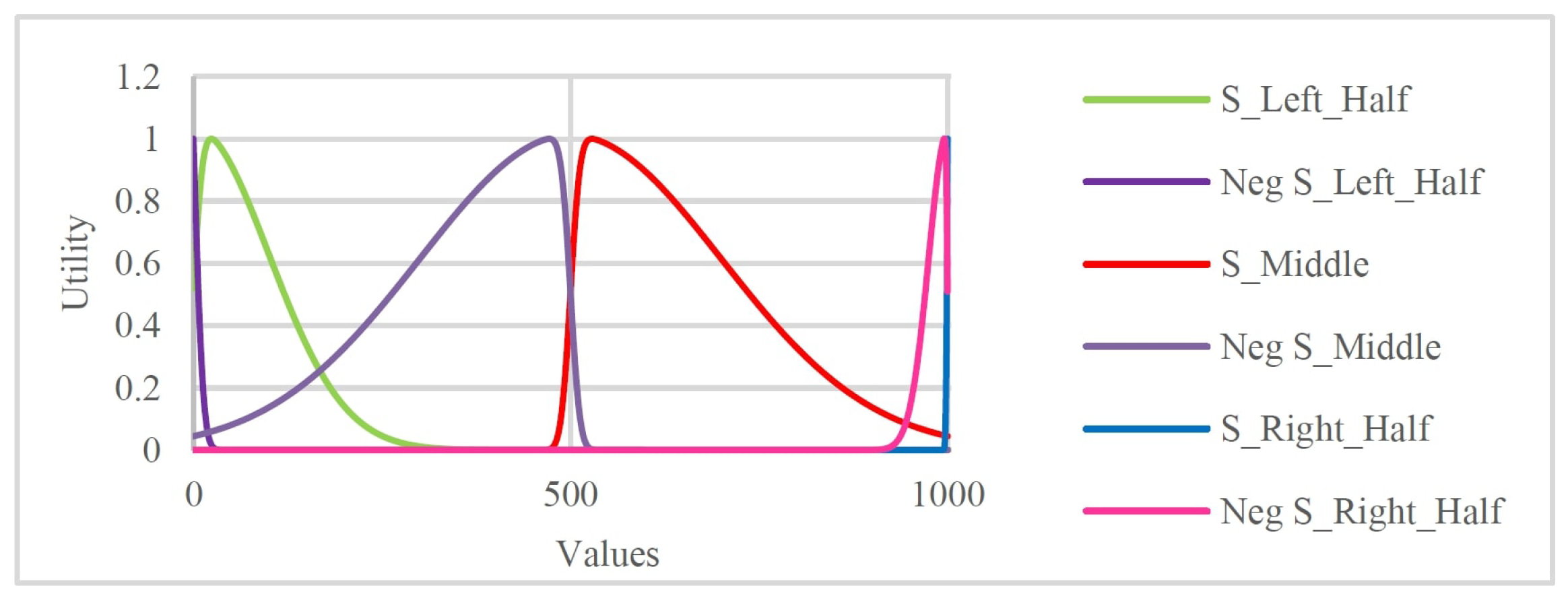

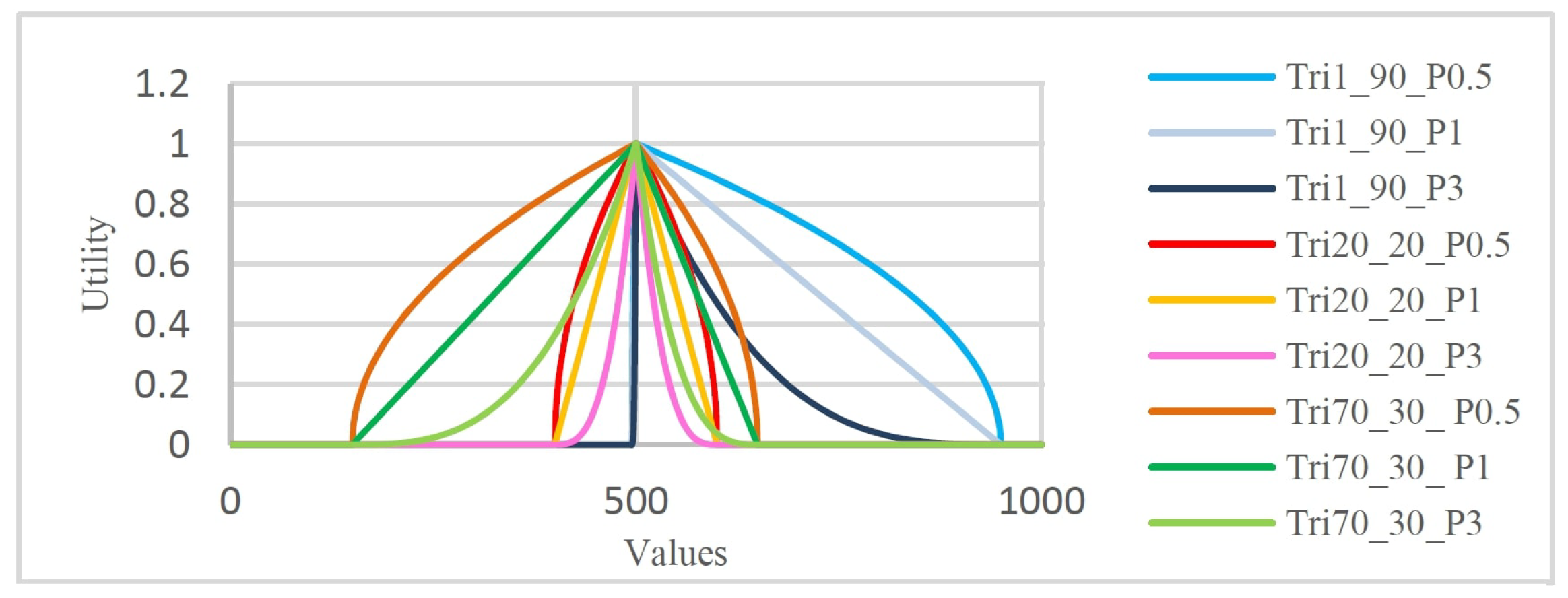
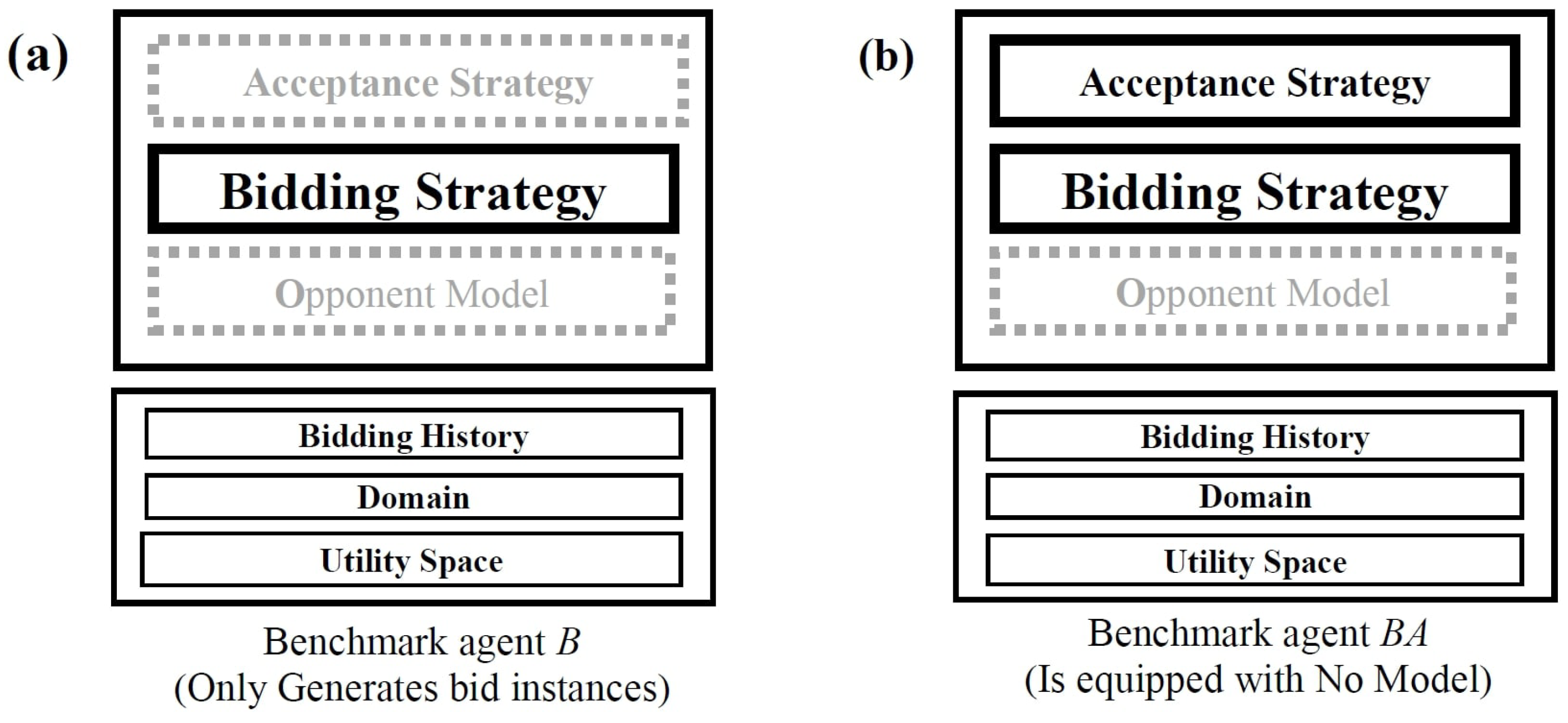
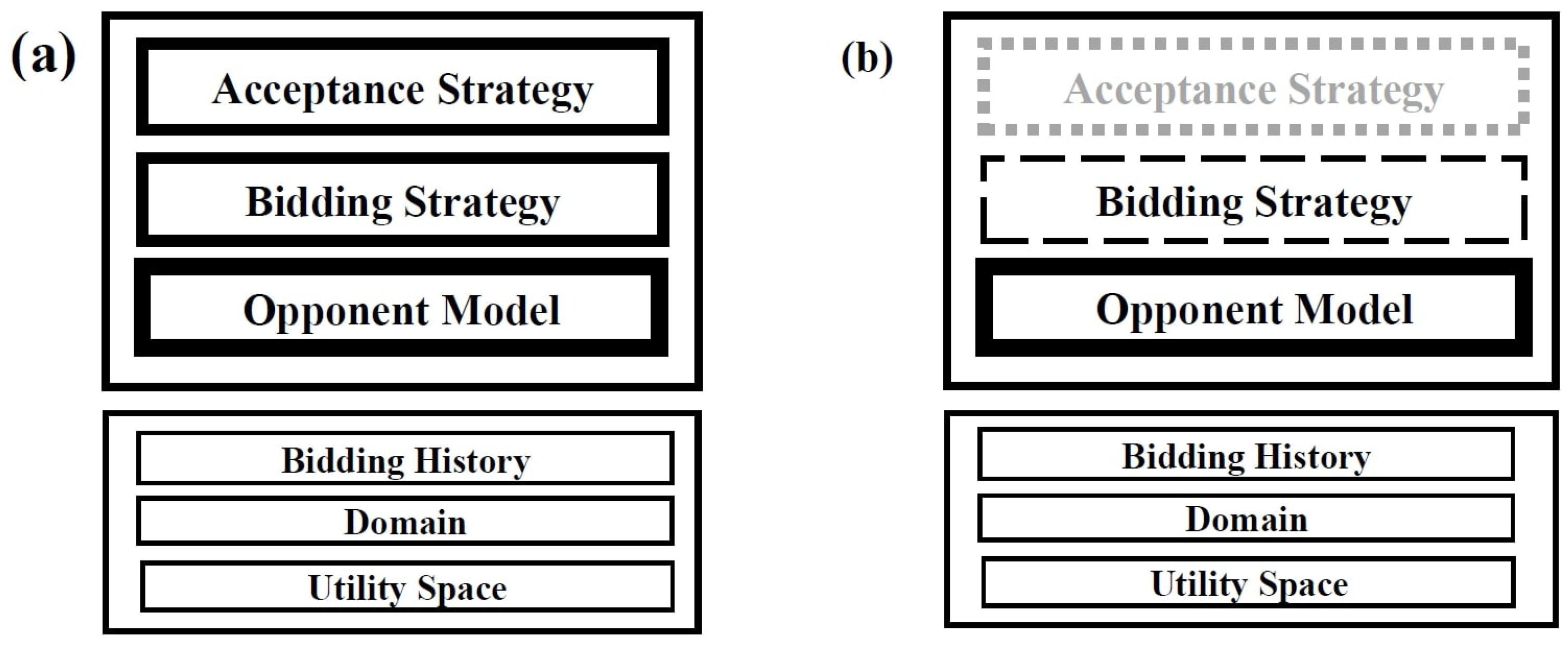
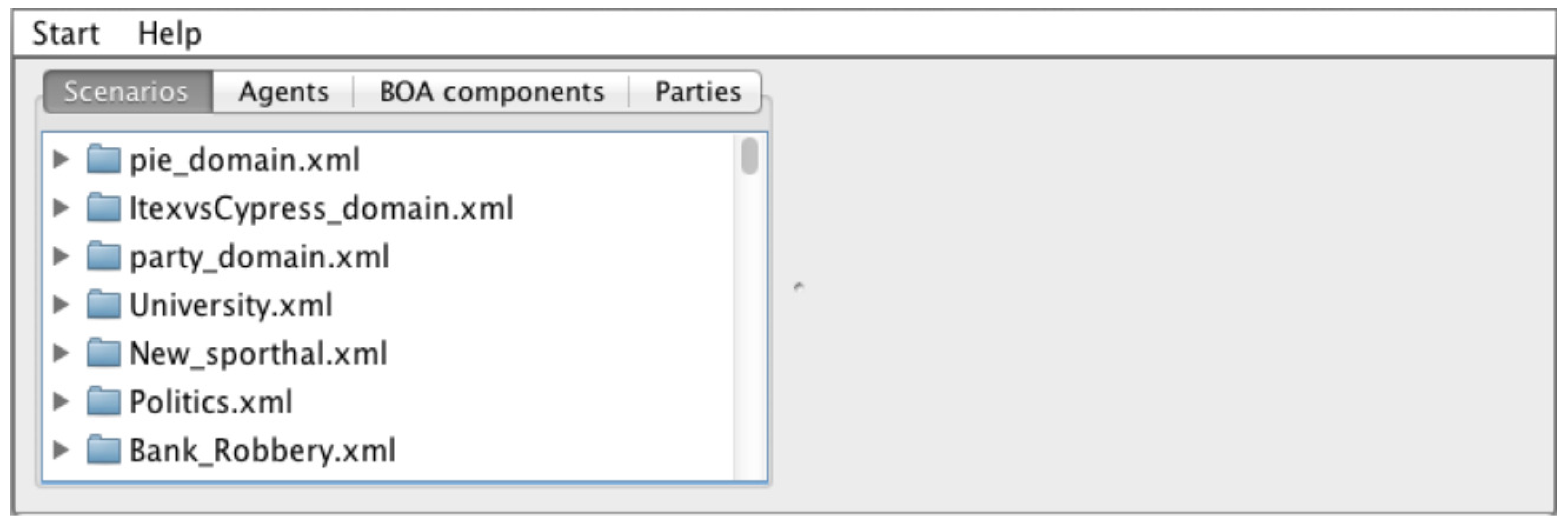



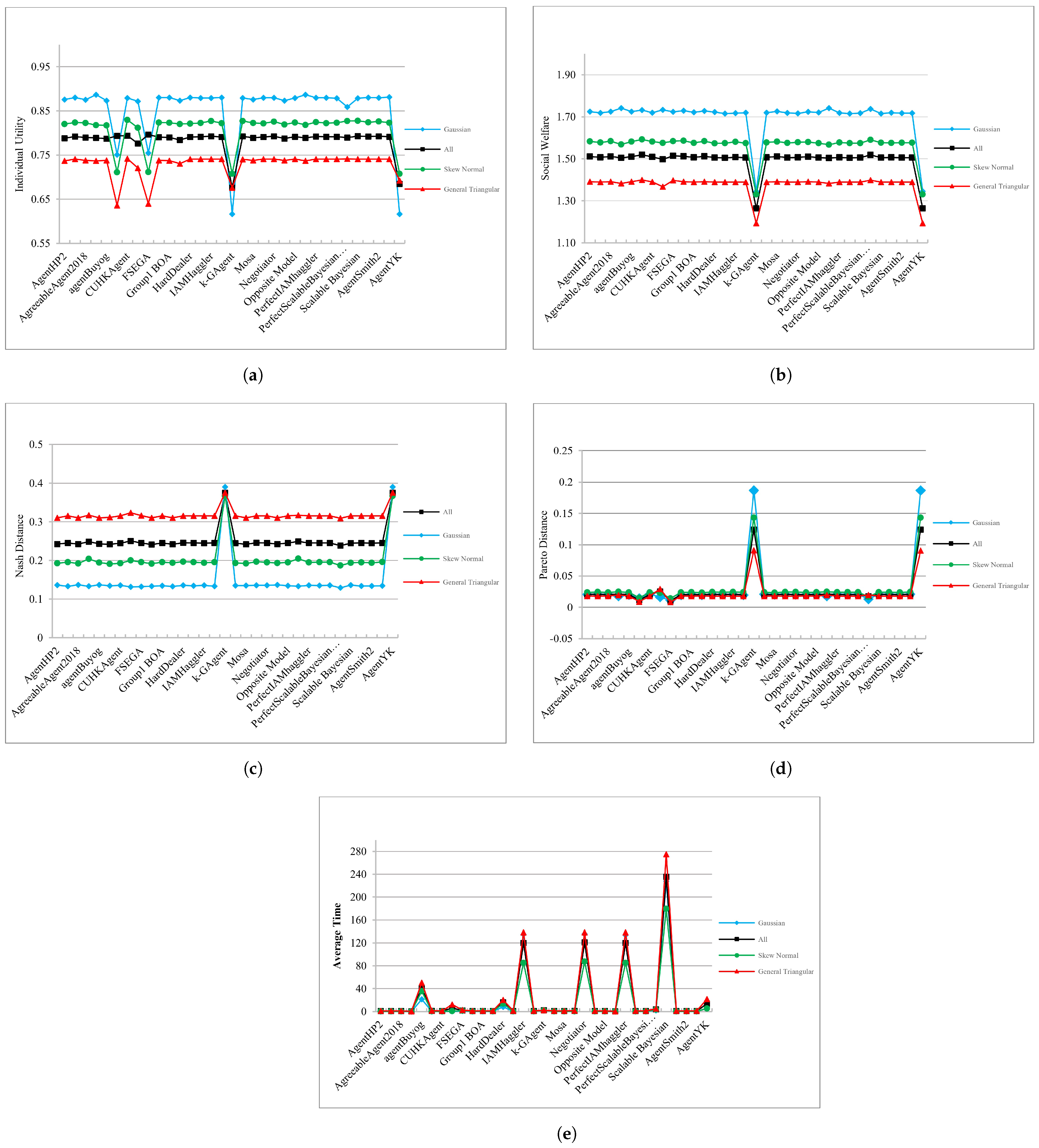
| Type | 1 | 2 | 3 | 4 | 5 | 6 | |
| Name | S_Left_Half | Neg S_Left_Half | S_Middle | Neg S_Middle | S_Right_Half | Neg S_Right_Half | |
| Parameter | 0.01 | 0.01 | 0.005 | 0.005 | 0.04 | 0.04 | |
| p | First value | First value | Median | Median | Last value | Last value | |
| Type | 1 | 2 | 3 | |
| Name | Left_Half | Right_Half | Middle | |
| Parameter | 0.01 | 0.04 | 0.005 | |
| p | First value | Last value | Median | |
| Type | 1 | 2 | 3 | 4 | 5 | 6 | 7 | 8 | 9 | |
| Name | Tri70_30_P3 | Tri70_30_P1 | Tri70_30_P0.5 | Tri20_20_P3 | Tri20_20_P1 | Tri20_20_P0.5 | Tri1_90_P3 | Tri1_90_P1 | Tri1_90_P0.5 | |
| Parameter | L | 70 | 70 | 70 | 20 | 20 | 20 | 1 | 1 | 1 |
| R | 30 | 30 | 30 | 20 | 20 | 20 | 90 | 90 | 90 | |
| p | Median | Median | Median | Median | Median | Median | Median | Median | Median | |
| 30 | 30 | 30 | 20 | 20 | 20 | 90 | 90 | 90 | ||
| h | 1 | 1 | 1 | 1 | 1 | 1 | 1 | 1 | 1 | |
| Notation | Description |
|---|---|
| Issues | All issues in the domain |
| issue | One issue in Issues |
| D_co | Copy of the domain |
| F_name | Function name selected by user |
| v | An issue value |
| p | Peak |
| Scale | |
| Shape | |
| h | Shape height |
| R | Right minimum |
| L | Left minimum |
| Power |
| Negotiation Type | Multi-Issue Bilateral |
| Deadline | Common Knowledge and Round-Based |
| Domain Type | Linear |
| Learning Between Sessions | No |
| Reservation Value | 1 |
| Domain Name | Domain Size (Issues, Bids) |
|---|---|
| Barter | Small (3, 80) |
| Itex vs. Cypress | Small (4, 180) |
| Airport Site Selection | Medium (3, 420) |
| Pie | Medium (1, 1001) |
| Smart Energy Grid | Medium (4, 625) |
| Energy Small | Large (6, 15, 625) |
| Energy | Large (8, 390, 625) |
| # | Agent Name | Country | Institution | Year | Rank | Opponent Model Type |
|---|---|---|---|---|---|---|
| 1 | Perfect IAMHaggler | - | - | - | - | Bayesian |
| 2 | Nash | - | - | - | - | Frequency |
| 3 | Scalable Bayesian | - | - | - | - | Bayesian |
| 4 | Perfect Scalable Bayesian | - | - | - | - | Bayesian |
| 5 | AgentSmith | The Netherlands | TU Delft | 2010 | 7F 1 | Frequency |
| 6 | IAMHaggler | England | University of Southampton | 2010 | 4F | Bayesian |
| 7 | Hardheaded | The Netherlands | TU Delft | 2011 | 1F | Frequency |
| 8 | CUHKAgent | China | The University of Hong Kong | 2012 | 1F | Frequency |
| 9 | AgentLG | Israel | Bar-Ilan University | 2012 | 2F | Frequency |
| 10 | AgentX | The Netherlands | TU Delft | 2012 | 13Q 2 | Frequency |
| 11 | Negotiator | The Netherlands | TU Delft | 2012 | 3F | Bayesian |
| 12 | TheFawkes | The Netherlands | TU Delft | 2013 | 1F | Frequency |
| 13 | InoxAgent | The Netherlands | TU Delft | 2013 | 6Q | Frequency |
| 14 | k-GAgent | Japan | Tokyo University of Agriculture and Technology | 2014 | 7F | Frequency |
| 15 | AgentYK | Japan | Shizuoka University | 2014 | 8F | Frequency |
| 16 | AP | Iran | University of Isfahan | 2014 | - | Perceptron |
| 17 | P1 | Iran | University of Isfahan | 2014 | - | Perceptron |
| 18 | RandomDance | Japan | Tokyo University of Agriculture and Technology | 2015 | 3F | Frequency |
| 19 | agentBuyog | Singapore | Nanyang Technological University | 2015 | 5F | Frequency |
| 20 | AgentHP2 | Japan | Tokyo University of Agriculture and Technology | 2016 | 10F | Frequency |
| 21 | AgentSmith2 | The Netherlands | TU Delft | 2016 | 16F | Frequency |
| 22 | GeneKing | Japan | Nagoya University | 2017 | 6F | Frequency |
| 23 | Mosa | USA | Southwest University | 2017 | 7F | Frequency |
| 24 | AgreeableAgent2018 | Iran | University of Tehran | 2018 | 1F | Frequency |
| 25 | Group Y | Turkey | Ozyegin University | 2018 | 6F | Frequency |
| 26 | ConDAgent | Greece | University of Crete | 2018 | 8F | Bayesian |
| 27 | FSEGA | Romania | Babeş–Bolyai University | 2019 | 2F | Bayesian |
| 28 | Group1 BOA | - | - | 2019 | 11F | Frequency |
| 29 | HardDealer | - | - | 2019 | 5F | Bayesian |
| 30 | No Model | - | - | - | - | Classic |
| 31 | Perfect Model | - | - | - | - | Classic |
| 32 | Worst Model | - | - | - | - | Classic |
| 33 | Opposite Model | - | - | - | - | Classic |
| Experiment | Components/ Negotiating Agent | Single-Peaked Preference Profile | Bidding Strategy | Acceptance Strategy | Opponent Model |
|---|---|---|---|---|---|
| Accuracy | Modeler | ✕ | ✓ | ✕ | ✓ |
| Bidder | ✓ | ✓ | ✕ | ✕ | |
| Performance | Modeler | ✕ | ✓ | ✓ | ✓ |
| Bidder | ✓ | ✓ | ✓ | ✕ |
| Benchmark Agent | Domain Size | The Most Accurate Model | Accuracy |
|---|---|---|---|
| All | Small | Perfect Scalable Bayesian | 0.386888 |
| Medium | CUHKAgent | 0.488432 | |
| Large | CUHKAgent | 0.608656 | |
| Gaussian | Small | Perfect Scalable Bayesian | 0.268901 |
| Medium | IAMhaggler Bayesian | 0.216265 | |
| Large | Perfect Scalable Bayesian | 0.269562 | |
| Skew-Normal | Small | Perfect IAMhaggler Bayesian | 0.188162 |
| Medium | P1 | 0.455543 | |
| Large | CUHKAgent | 0.577745 | |
| General Triangular | Small | Randomdance | 0.762287 |
| Medium | Groupy | 0.680891 | |
| Large | Groupy | 0.835907 |
| Top Model * | Measure | |||||
|---|---|---|---|---|---|---|
| Opponent | Individual Utility | Social Welfare | Pareto Distance | Time | Nash Distance | |
| (1) | 0.796499: FSEGA | 1.518985: CondAgent | 0.010909: FSEGA | 0.130557: P1 | 0.238543: Randomdance | |
| (1) † | 0.794041: CUHKAgent | 1.518306: Randomdance | 0.017778: Randomdance | 0.130557: P1 | 0.238543: Randomdance | |
| (2) | 0.886457: AP, P1 | 1.741716: AP, P1 | 0.011423: FSEGA | 0.047787: P1 | 0.128945: Randomdance | |
| (2) † | 0.886457: AP, P1 | 1.741716: AP, P1 | 0.013247: Randomdance | 0.047787: P1 | 0.128945: Randomdance | |
| (3) | 0.829467: CUHKAgent | 1.591632: CondAgent | 0.014377: FSEGA | 0.083414: P1 | 0.187083: Randomdance | |
| (3) † | 0.829467: CUHKAgent | 1.589593: Randomdance | 0.016933: Randomdance | 0.083414: P1 | 0.187083: Randomdance | |
| (4) | 0.741977: CUHKAgent | 1.399601: CondAgent | 0.008426: FSEGA | 0.189577: P1 | 0.309383: Randomdance | |
| (4) † | 0.741977: CUHKAgent | 1.397974: Randomdance | 0.017757: AgentX, Group1, HardDealer, Hardheaded, IAMhaggler Bayesian, Inox, LG, Negotiator, Opposite Model, Perfect IAMhaggler Bayesian, Perfect Model, Perfect Scalable Bayesian, Scalable Bayesian, Smith1, Smith2, Worst Model | 0.189577: P1 | 0.309383: Randomdance | |
| # | Agent Name | Nash Distance | Average Time | Pareto Distance | Social Welfare | Individual Utility |
|---|---|---|---|---|---|---|
| 1 | Perfect IAMHaggler | 2 | 0 | 10 | 2 | 7 |
| 2 | Nash | 2 | 0 | 9 | 2 | 7 |
| 3 | Scalable Bayesian | 4 | 0 | 9 | 1 | 4 |
| 4 | Perfect Scalable Bayesian | 2 | 0 | 10 | 2 | 7 |
| 5 | AgentSmith | 2 | 1 | 10 | 2 | 7 |
| 6 | IAMHaggler | 5 | 0 | 9 | 3 | 7 |
| 7 | Hardheaded | 2 | 0 | 10 | 2 | 7 |
| 8 | CUHKAgent | 3 | 0 | 8 | 3 | 12 |
| 9 | AgentLG | 2 | 0 | 10 | 2 | 7 |
| 10 | AgentX | 2 | 0 | 10 | 1 | 7 |
| 11 | Negotiator | 3 | 0 | 9 | 3 | 7 |
| 12 | TheFawkes | 1 | 0 | 1 | 0 | 1 |
| 13 | InoxAgent | 2 | 0 | 10 | 2 | 7 |
| 14 | k-GAgent | 1 | 1 | 0 | 0 | 0 |
| 15 | AgentYK | 0 | 0 | 0 | 0 | 1 |
| 16 | AP | 3 | 4 | 5 | 9 | 5 |
| 17 | P1 | 4 | 30 | 5 | 9 | 5 |
| 18 | RandomDance | 22 | 0 | 14 | 16 | 9 |
| 19 | agentBuyog | 6 | 0 | 3 | 2 | 1 |
| 20 | AgentHP2 | 4 | 2 | 3 | 2 | 1 |
| 21 | AgentSmith2 | 2 | 0 | 10 | 2 | 7 |
| 22 | GeneKing | 6 | 3 | 4 | 4 | 3 |
| 23 | Mosa | 6 | 0 | 3 | 2 | 1 |
| 24 | AgreeableAgent | 6 | 3 | 3 | 2 | 1 |
| 25 | Group Y | 6 | 4 | 3 | 2 | 2 |
| 26 | ConDAgent | 6 | 0 | 3 | 5 | 1 |
| 27 | FSEGA | 2 | 0 | 13 | 2 | 2 |
| 28 | Group1 BOA | 2 | 0 | 10 | 2 | 7 |
| 29 | HardDealer | 2 | 0 | 10 | 2 | 7 |
| 30 | No Model | 4 | 2 | 3 | 2 | 1 |
| 31 | Perfect Model | 2 | 0 | 11 | 2 | 7 |
| 32 | Worst Model | 2 | 0 | 10 | 2 | 5 |
| 33 | Opposite Model | 3 | 0 | 9 | 3 | 8 |
Disclaimer/Publisher’s Note: The statements, opinions and data contained in all publications are solely those of the individual author(s) and contributor(s) and not of MDPI and/or the editor(s). MDPI and/or the editor(s) disclaim responsibility for any injury to people or property resulting from any ideas, methods, instructions or products referred to in the content. |
© 2024 by the authors. Licensee MDPI, Basel, Switzerland. This article is an open access article distributed under the terms and conditions of the Creative Commons Attribution (CC BY) license (https://creativecommons.org/licenses/by/4.0/).
Share and Cite
Hassanvand, F.; Nassiri-Mofakham, F.; Fujita, K. Automated Negotiation Agents for Modeling Single-Peaked Bidders: An Experimental Comparison. Information 2024, 15, 508. https://doi.org/10.3390/info15080508
Hassanvand F, Nassiri-Mofakham F, Fujita K. Automated Negotiation Agents for Modeling Single-Peaked Bidders: An Experimental Comparison. Information. 2024; 15(8):508. https://doi.org/10.3390/info15080508
Chicago/Turabian StyleHassanvand, Fatemeh, Faria Nassiri-Mofakham, and Katsuhide Fujita. 2024. "Automated Negotiation Agents for Modeling Single-Peaked Bidders: An Experimental Comparison" Information 15, no. 8: 508. https://doi.org/10.3390/info15080508
APA StyleHassanvand, F., Nassiri-Mofakham, F., & Fujita, K. (2024). Automated Negotiation Agents for Modeling Single-Peaked Bidders: An Experimental Comparison. Information, 15(8), 508. https://doi.org/10.3390/info15080508







